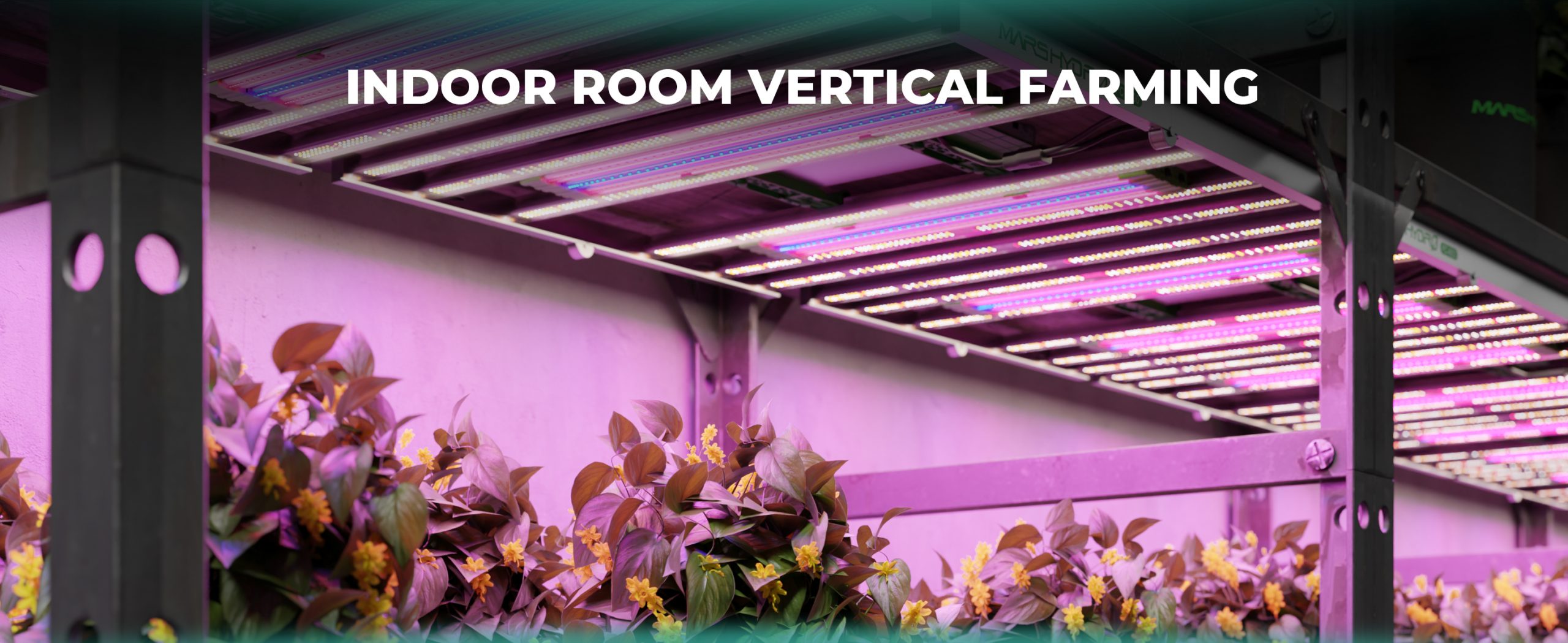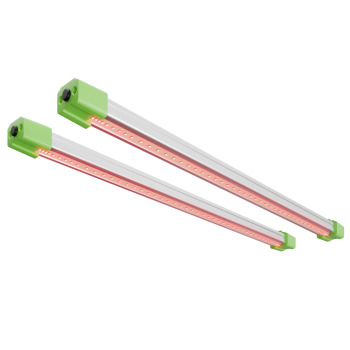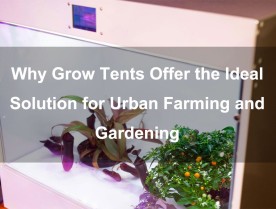
In the realm of indoor gardening, achieving optimal plant growth and maximizing yields is a nuanced art, heavily reliant on precise environmental conditions. Recognizing the limitations of natural sunlight and conventional lighting solutions in fully meeting these specific needs, we have introduced ADLITE. These specialized UV, IR, and Red lights are designed to fill the spectral gaps, providing plants with the essential wavelengths they require for optimal growth and development.
Table of Contents
Why Adding UV/IR/Red Light is Beneficial
Spectrum Customization and Maximum Light Utiliza tion
tion
These supplemental lighting solutions provide the capability for exact spectrum customization, finely tuned to meet the distinct needs of plant photosynthesis at each stage of growth. By aligning the light spectrum with the precise wavelengths that plants absorb most efficiently, these lights ensure that every photon emitted is used to its fullest potential. This not only optimizes light energy utilization but also promotes healthier plant growth, increases yield, and enhances the overall efficiency of the photosynthetic process. Through targeted spectral adjustments, growers can stimulate specific growth responses, improve stress tolerance, and even influence the flavor and nutritional content of the crops, making these lights an invaluable tool for maximizing the benefits of indoor gardening.
Precise Lighting for Energy Efficiency
Implementing individual control over supplemental lighting facilitates targeted illumination, channeling energy precisely to where it's most needed throughout the various phases of plant growth. This methodical approach enhances the efficiency and effectiveness of lighting, ensuring plants are exposed to the optimal wavelengths at each stage of their development—ranging from seedling, through vegetative growth, to flowering and fruiting. By finely tuning both the direction and intensity of light, growers can significantly reduce wasted energy, directing resources only to areas and times where light is beneficial.
This strategic adjustment of lighting based on the plant's lifecycle not only curtails unnecessary energy use but also tailors the light spectrum to the evolving requirements of the plant. Such precision prevents the indiscriminate application of wavelengths that offer little to no value at certain stages, thereby conserving energy. The practice of adjusting light settings to match growth stages ensures that no watt of energy is squandered, optimizing plant health and growth efficiency.
The culmination of these efforts is a growing operation that is both more sustainable and economically viable. By minimizing energy consumption and focusing on the efficient use of light, growers can achieve a balance between enhancing plant growth and reducing environmental footprint. The outcome is an optimized growing environment that maximizes yield potential while ensuring every aspect of the lighting system contributes positively to the plant's development, health, and productivity.
Control and Timing Flexibility
UV (ultraviolet) and IR (infrared) lighting must be equipped with separate switches to control their use effectively, as each type of light has distinct effects on plant health and growth cycles. UV light, while beneficial in small doses for stimulating the production of disease-resistant compounds and enhancing the synthesis of valuable phytochemicals, can be harmful to plants if used excessively. Long-term exposure to UV light can cause photobleaching and stress to plants, necessitating careful management of its application. On the other hand, IR light plays a crucial role in regulating plants' sleep-wake cycles, influencing photoperiodism and other physiological processes that guide the transition between growth phases. However, like UV light, IR cannot be applied continuously without potentially negative effects.
Mars Hydro's lighting solutions provide growers with the precision needed to harness the benefits of UV and IR light without risking overexposure. By allowing for independent control over these wavelengths, growers can adjust lighting to match the specific needs of their plants at each stage of growth. This is especially critical during the sensitive seedling and vegetative stages, where the right amount of UV light can promote health and vigor without causing damage. The separate control over IR lighting further empowers growers to mimic natural daylight cycles, inducing flowering at just the right moment. This capability ensures that plants receive the optimal conditions for healthy growth cycles and bloom production, enhancing both yield and quality without unnecessary energy expenditure.
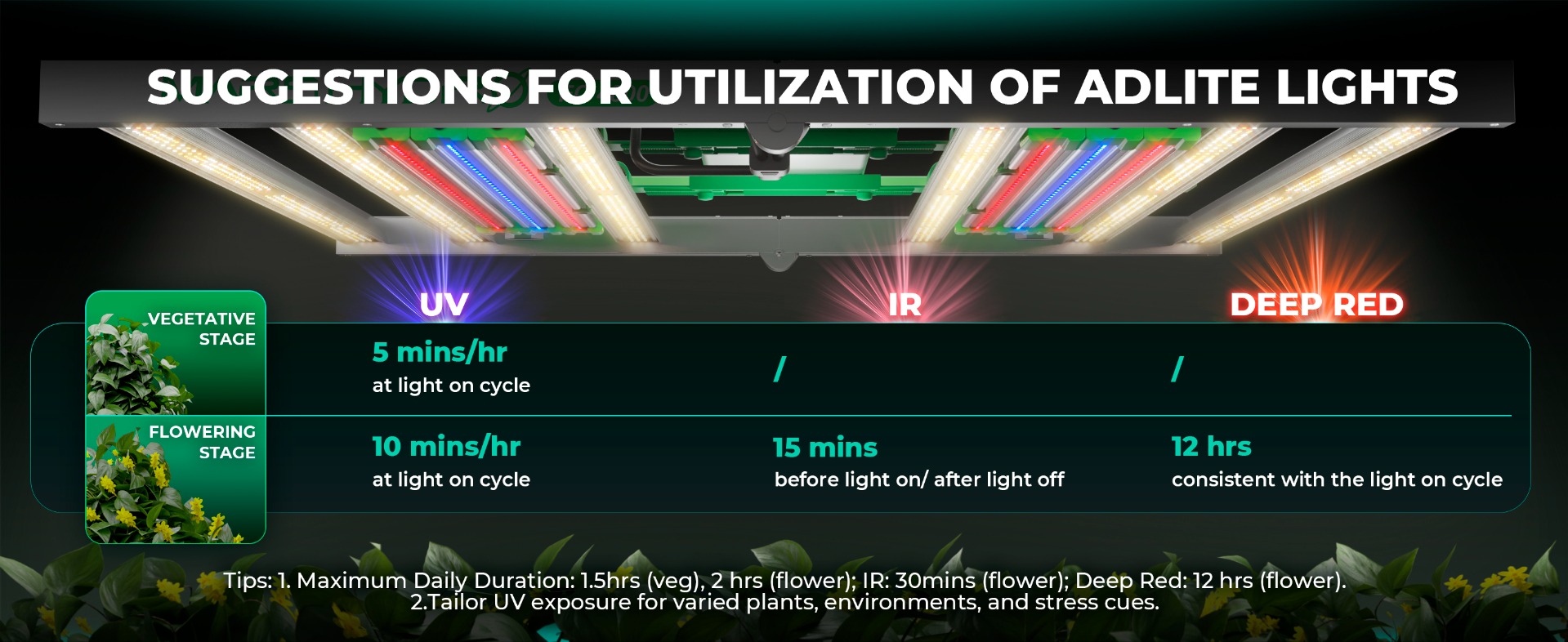
The integrated approach of Mars Hydro's lighting systems, with the ability to fine-tune UV and IR exposure, supports adaptive lighting strategies. These strategies can be adjusted according to the plant's growth stage and the environmental conditions, maximizing photosynthetic efficiency and ensuring robust growth throughout the lifecycle.
In essence, Mars Hydro's supplemental lighting systems offer a strategic advantage by allowing precise and responsive control over UV and IR light exposure. This not only protects plants from the potential harms of overexposure but also optimizes energy consumption. Providing the right amount of light at the right time ensures that energy is used efficiently, contributing directly to the plant's development, health, and productivity. This approach exemplifies the ideal balance of precision, efficiency, and care in modern plant cultivation practices.
Enhancing Growth and Yield at Lower Costs
Integrating red light into the illumination strategy during the flowering stage of plant growth presents a cost-effective and efficient method to enhance both growth and yield. This approach leverages the specificity of red light's impact on plants during their flowering phase, optimizing the conditions for increased productivity without a proportionate increase in energy consumption or costs.
Consider the scenario where an 800W main light is supplemented with 55W of red light. This combination can achieve the same level of light intensity as an 855W main light alone but brings additional benefits tailored specifically to the flowering stage. The key here is that red light, with its particular wavelength, is more effective in stimulating the flowering process in plants than the broader spectrum provided by the main light. Therefore, the supplemental 55W of red light not only compensates for the intensity but also enhances the quality of light during a critical phase of plant development.
Furthermore, the strategic use of red light enables energy savings during the vegetative (VEG) stage of growth. Since red light is particularly beneficial during the flowering stage, it's not necessary to employ this additional energy during the VEG stage. This allows for a reduction in the wattage of the main light used during this earlier phase, as the specific advantages of red light are not required, thus conserving energy.
We advise customers to consider this strategy when planning their lighting needs. By opting for a lower wattage main light and supplementing with targeted red light during the flowering stage, growers can significantly reduce their energy consumption and, consequently, their operational costs. This approach not only makes economic sense but also aligns with sustainable growing practices by minimizing energy waste and optimizing the use of supplemental lighting for the most impact.
In summary, the judicious application of red light during the flowering stage, complemented by a reduction in main light wattage during the vegetative stage, offers a dual benefit of enhancing plant growth and yield while simultaneously lowering energy costs. This strategy underscores the importance of tailored lighting solutions in indoor growing environments, emphasizing efficiency, cost-effectiveness, and sustainability.
Why Not Simply Incorporate UV and IR into Full Spectrum Lights?
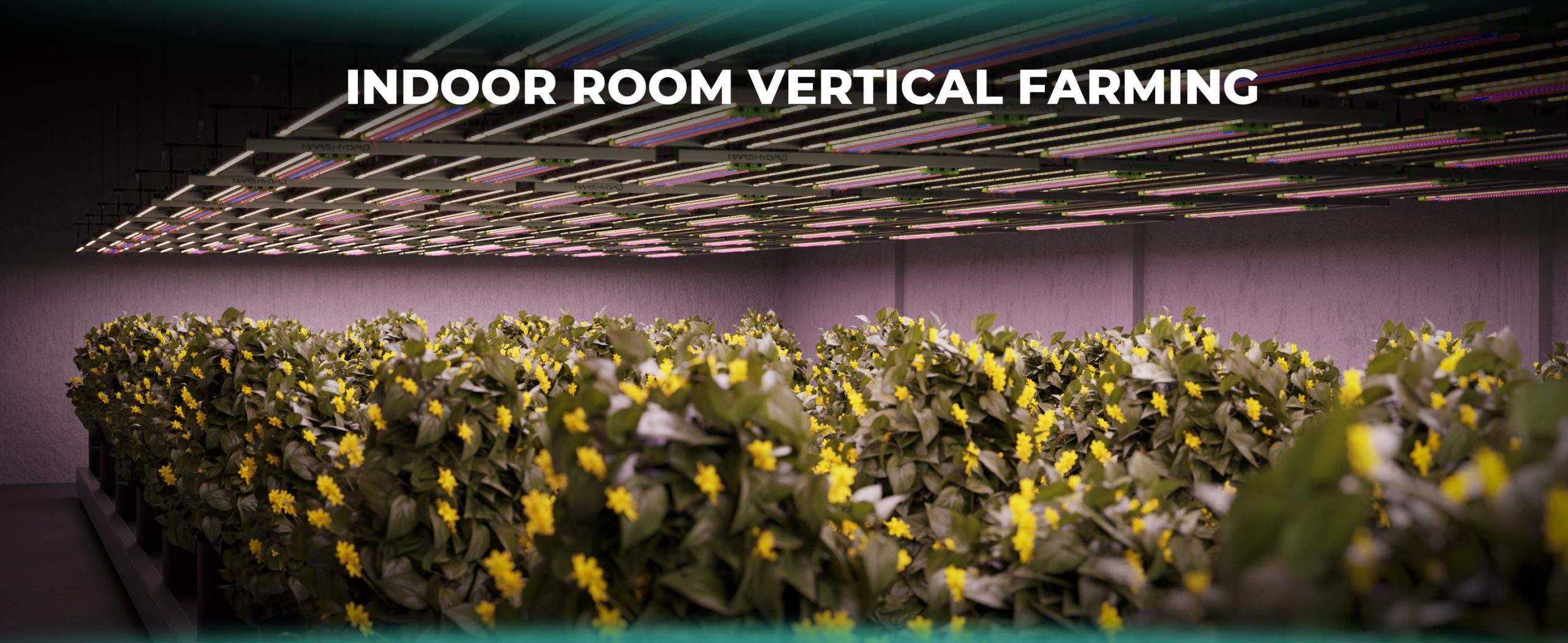
Lack of Timing Control
Precise control over the timing of UV (ultraviolet) and IR (infrared) light exposure is crucial due to their distinct effects on plant growth and development. UV light, when used correctly, can enhance disease resistance and stimulate the production of certain phytochemicals. However, excessive exposure can damage plant DNA and tissues, leading to stress or inhibited growth. Similarly, IR light plays a critical role in regulating plant sleep cycles and can affect flowering and germination. The ability to control these lights independently allows for the mimicry of natural light cycles and can trigger specific growth responses at the appropriate times. Unfortunately, many main lights with built-in UV/IR diodes lack the functionality for supplemental light timing control.
Increased Failure Rate Due to Complexity
Integrating UV and IR lights into a full-spectrum LED system introduces additional electrical components, such as circuits and power sources, to accommodate the different requirements of these light types. This complexity not only poses manufacturing challenges but also introduces more potential points of failure within the system. Each additional component—whether it's a separate LED driver, circuitry for independent control, or backup batteries for programmable features—increases the risk of malfunctions. A failure in one component can compromise the functionality of the light, affecting its reliability and longevity.
Inefficacy of Embedded UV and IR
The effectiveness of UV and IR lighting in promoting plant growth and health largely depends on the intensity and quality of the emitted light. Plants require specific wavelengths within the UV and IR spectra to trigger certain physiological responses, such as stress defense mechanisms, flowering, and vegetative growth regulation. However, many lighting systems that claim to include UV and IR capabilities fall short in delivering these wavelengths at intensities necessary to be truly beneficial. Insufficient UV light may not provide the expected stress signaling benefits, while inadequate IR light might fail to properly influence photoperiodic responses and flowering cycles. This inefficacy can lead to suboptimal growth conditions, where plants do not fully realize their potential in terms of yield, quality, or health. Therefore, integrating UV and IR into full-spectrum solutions requires not just the inclusion of these wavelengths but also careful consideration of their intensities and the overall spectral balance to ensure they meet the specific needs of plants at different growth stages.
Maximizing Potential with Mars HydroADLITE

Maximized Yields in Limited Spaces
Mars Hydro ADLITE Series is engineered to optimize the light environment within confined indoor spaces, where every bit of space and light must be utilized efficiently. By providing a spectrum of light that closely matches the photosynthetic active radiation (PAR) preferred by plants, these lights ensure that plants receive the precise wavelengths needed for photosynthesis and healthy growth. Additionally, Mars Hydro's lighting solutions are designed to distribute light evenly, reducing shadows and hotspots that can lead to uneven growth. This uniform distribution ensures that all plants, regardless of their position in the grow space, receive adequate light, promoting consistent growth across the entire canopy. The strategic use of supplemental lighting, such as targeted spectrums for vegetative and flowering stages, further maximizes yield by enhancing the rate of photosynthesis, encouraging denser foliage, and supporting more fruitful flowering, all within the spatial limitations of indoor gardens.
Energy Efficiency Through Stage-Specific Lighting
The concept of stage-specific lighting involves adjusting the light spectrum and intensity to match the needs of plants at different phases of their lifecycle, from seedling to vegetative growth and through to flowering and fruiting. Mars Hydro ADLITE Series is equipped with adjustable spectrum controls, allowing growers to emphasize right light for plant growth without the need for additional energy expenditure on unnecessary wavelengths. This precision not only reduces energy consumption by avoiding over-illumination but also minimizes stress on plants by providing them with the ideal light conditions for each stage of growth. Furthermore, Mars Hydro incorporates energy-efficient LED technology that consumes less power compared to traditional lighting systems while delivering higher light output, contributing to the sustainability of indoor gardening practices. By optimizing light quality and quantity according to plant growth stages, Mars Hydro ADLITE Series ensures that energy is not wasted on non-beneficial wavelengths, thus enhancing overall energy efficiency and reducing the carbon footprint of indoor horticulture.
These benefits underscore the importance of choosing the right lighting system for indoor gardening endeavors. Mars Hydro's supplemental lighting solutions offer a blend of technological innovation and practical efficiency, designed to meet the nuanced needs of plants while catering to the sustainability and productivity goals of modern gardeners. Through careful spectral management and energy-efficient designs, Mars Hydro can help indoor gardeners achieve remarkable success, even in the most limited of spaces.
Conclusion
By offering precise, customizable spectra with UV, IR, and Red lights, these innovations address the intricate requirements of plant growth stages, enhancing yield, plant health, and crop quality efficiently. This strategic approach not only ensures energy savings and sustainability but also empowers growers with the flexibility to fine-tune their lighting environment for maximum productivity.
Our commitment to blending cutting-edge LED technology with real-world efficiency reflects our deep understanding of the intricate demands of modern indoor gardening. By ensuring every joule of energy contributes to fostering healthier and more vigorous plant growth, we underscore our dedication to optimizing the indoor gardening experience for growers everywhere.


